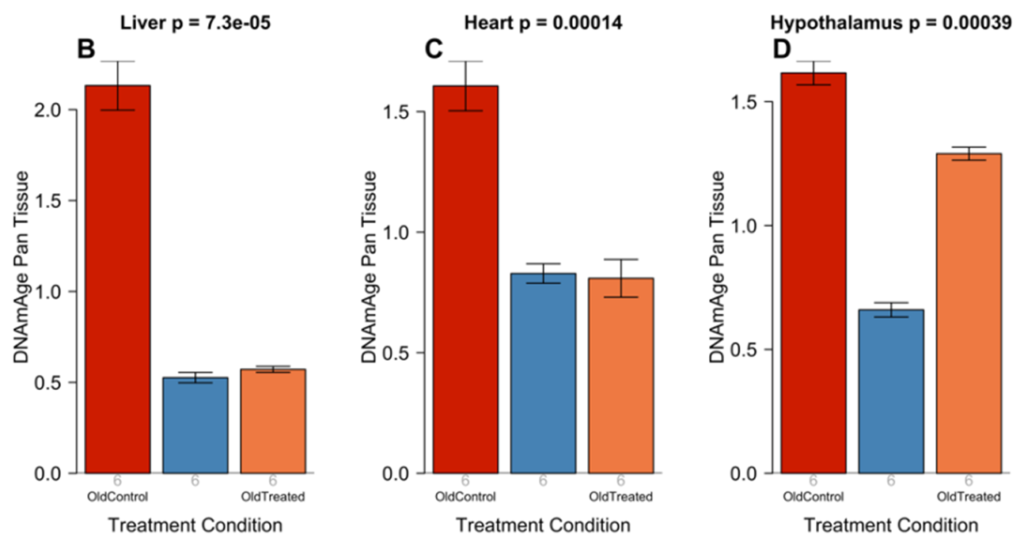UCLA Study Reveals Young Pig Plasma Reverses Organ Aging and Age-Related Cognitive Decline
Researchers find that injecting aged rats with plasma from young pigs reverses the biological age of multiple vital organs and decreases oxidative stress and inflammation.
Highlights:
- Injecting aged rats with plasma – the liquid portion of blood – from young pigs reverses the biological age of their liver, heart, and brain.
- Plasma treatment enhances learning and memory, and mitigates two hallmarks of aging: oxidative stress and inflammation.
Animal studies have demonstrated that young plasma contains several critical factors capable of supporting tissue repair and regeneration. However, researchers have yet to determine whether these factors actually have the ability to simultaneously rejuvenate and reverse the biological age of aged tissues.
Now, in a preprint article published in bioRxiv, researchers from the University of California Los Angeles (UCLA) report that injecting aged rats with plasma from young pigs successfully reverses the biological age of multiple vital organs, including the liver, heart, and brain. What’s more, the investigators found that young plasma treatment improved the function of these organs while quenching oxidative stress and inflammation.
Young Plasma Rejuvenates Aged Organs
Although chronological age tells us how many years we’ve existed on this Earth, molecular indicators reveal how much we have aged biologically and tell us if our bodies have experienced accelerated aging. Notably, scientists have utilized these molecular indicators, particularly in DNA, to develop biological (epigenetic) clocks that can accurately predict one’s true biological age. Furthermore, utilizing these biological clocks has allowed researchers to rigorously investigate the effectiveness of aging interventions, like young plasma injections, in their potential to reverse the aging process at the molecular level.
With this in mind, the UCLA researchers employed six unique rat-specific biological clocks to determine whether young pig plasma could reverse the biological age of aged rat tissues in multiple organs. The results showed that young pig plasma successfully reversed the biological age of the liver, heart, and brain of aged rats by 74.6%, 46.5%, and 24.4%. Moreover, the treatment’s capacity to effectively revert the biological age of several vital organs implies that young pig plasma has the potential to address a diverse spectrum of age-related diseases.

Young Pig Plasma Enhances the Function of Rejuvenated Organs
Given the observed reversal of biological organ aging, the investigators were curious to see if this correlated with improved organ functionality. After completing treatment with young pig plasma, the investigators subjected aged rats to the Barnes maze test, a spatial learning and memory test that measures the rat’s ability to locate an escape hole on a circular platform. Shortly after treatment, both groups exhibited comparable performance, requiring nearly the same amount of time to locate the concealed escape hole. However, one month after treatment, treated rats took significantly less time than untreated rats to escape the maze, indicating that young pig plasma restores cognitive function.
The UCLA researchers proceeded to assess functional markers in the remaining organs (heart and liver) and found that young pig plasma increased the levels of several markers known to support and sustain heart and liver function during the aging process. Remarkably, the investigators also found that treatment substantially diminished markers of oxidative stress and inflammation, two factors responsible for driving aging and disease. Collectively, the study’s findings suggest that young pig plasma can reverse organ aging at the molecular level, rejuvenate organ function, and curb two hallmarks of aging.

Is Young Plasma The Next Anti-Aging Therapy?
Young plasma shows promise in the field of anti-aging therapy, but it’s crucial to exercise caution and acknowledge that its full potential is still under investigation. Furthermore, the application of young plasma for anti-aging purposes in humans requires rigorous research, addressing ethical concerns, regulatory approval, and long-term safety and efficacy data. That being said, the current data has provided some promising results, with multiple studies now showing that young plasma can ameliorate age-related cognitive decline and rejuvenate aged tissues. Moreover, the fact that young plasma effectively blunts oxidative stress and inflammation further highlights its potential to optimize organ aging and delay the onset of age-related diseases.
Model: Male Sprague Dawley Rats (18-24 months old)
Dosage: Plasma fraction treatment consists of two series of intravenous injections of E5. Rats were injected four times on alternate days for 8 days. A second identical series of injections were administered 95 days later
“Several assumptions underpinned the dosing for old rats (18 to 24 months old). These included estimations of blood mass as a percentage of body mass, the half-volume of plasma, the presence of pro-aging factors in old rat plasma, equivalence in concentration of anti-aging factors between young pig and rat blood, and preservation efficacy of the PEG process. Based on these assumptions, and in consideration of concentration-dependency of exosome rejuvenation, the dosing was calculated such that the delivered pig anti-aging components would quadruple the concentration that would be present in young rat blood. This amounted to 1.43 grams of solid precipitate per 500 grams rat, administered as four injections every other day via tail veins”

